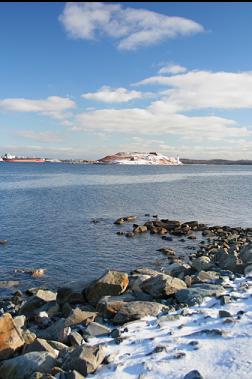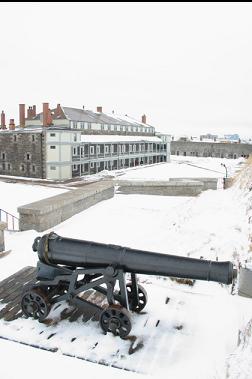I did around 15 dives in Halifax in Jan./Feb., 2008. As I found last time, there aren't any boat charters running this time of year so I rented a car, photocopied some charts and went off on my own. In order to convince the locals to dive all year around, the dive industry here declares that winter has the best visibility (the same ploy as in B.C.). Unfortunately, I found it to be pretty terrible (6-10 feet on average). There is also very little mobile marine life here in the winter. Depending on who you talk to, the fish/lobster either "go deep", "bury themselves in the sand and hibernate" or "go south". I only saw a total of 3 fish during all my dives. Air temperatures ranged from around 0 degrees to -17. I don't know what the water temperature was, but in many of the protected bays and inlets it was frozen over. On the colder days, the seawater would freeze on my drysuit and ice would build up on my mask when I rinsed it off in the ocean. Of course I still got in the water every chance I could, but hopefully next time I show up here in the summer.
There were quite a few more places that I tried to go that didn't work out.
Chebucto Head has the wrecks of the Isleworth and A.W. Perry. It's a popular boat charter spot in the summer and apparently you can dive it from shore if you don't mind a hike. I tried to dive here just about every day on the weekends, but even on calm, windless days with a small, less than 6-foot swell, the waves were crashing over the protective islets and surging up into the "sheltered" entry spot making it impossible to get in the water. Oh well.
Up the coast from Halifax in Sheet Harbour, there is the fairly recent wreck of the Arctic Trader. It's some kind of 180-foot-or-so long freighter only 30 feet deep, close to shore, just off a dock. I tried to find out on the internet if it was still there (the minutes from a Sheet Harbour chamber of commerce meeting a few months ago recorded that there were people interested in removing it), but I had no luck. I decided to go for the hour-and-a-half drive and find out for myself. When I got there the water looked like chocolate milk. I was hoping the water would clear a bit under the surface, but at 10 feet deep it was pitch black and I got creeped out and gave up. The last thing I wanted was to drop down into a fishing net or hole in the wreck that was invisible in the 1-inch visibility. So I drove back to Halifax muttering to myself instead.
I tried diving in front of the Peggy's Cove lighthouse a few times, but the swell was too much to get in the water.
Polly's Cove is supposed to be a sheltered diving spot with a small wall and part of a freighter wreck (Hulda). According to the local maritime museum's website, the wreck was cut up and removed recently, but local divers insist it's still there. There's a narrow gravel road leading to a trail that takes you to the water. Unfortunately, the road had flooded and then frozen, turning into a long, narrow skating rink. I couldn't drive it, but I tried carefully walking it. Eventually I slipped my way to the end where there are some concrete foundations overlooking the water and I could see that, even though it was a calm day, the waves were crashing around the islands offshore and slamming into the "protected" entry spot. So I left.
There were several other nameless spots I considered diving between Halifax and St. Margaret's Bay, but either the visibility was measured in inches (the water often looked like strong, yellow-brown tea) or the swell made entry impossible.






